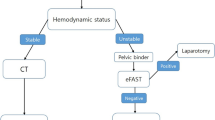Abstract
Background
Morel-Lavallee lesion (MLL) of the peri-pelvic region is less common and various treatments have been introduced to manage the lesion. No standard treatment is recommended. We performed a systematic review of literature to (1) identify the classification of peri-pelvic MLL; (2) review the treatments of the lesion and their complications; (3) define the optimal treatment of peri-pelvic MLL.
Methods
A systematic search was performed via PubMed, ISI Web of Knowledge, and Embase for English abstract articles from 1966 to 2012. We identified 21 articles detailing 153 patients with peri-pelvic MLL, most of which were level IV studies. The treatments and clinical results were reviewed.
Results
For peri-pelvic MLL patients, surgical intervention was better than conservative therapy. Sclerhodesis method is attended with good outcome in the symptomatic MLL patients without fractures. Patients with peri-pelvic fractures could be managed with local suction drainage or open debridement with dead space closure technique during fracture fixation. The delayed-diagnosis cases might be treated with mass resection when fibrosis capsule was obtained in magnetic resonance imaging.
Conclusions
Peri-pelvic MLL can be treated with various surgical methods depending on the formation of fibrosis capsule and associated injuries. Dead space closure technique is emphasized in the treatment of MLL. Higher quality of literature is required to prove this result in future research.

Similar content being viewed by others
References
Morel-Lavallee (1863) Decollements traumatiques de la peau et des couches sous-jacentes. Arch Gen Med (1):20-38, 172-200, 300–332
Vico PG (2000) Morel-Lavallee syndrome. Eur J Plast Surg 23(1):45–48
Parra JA, Fernandez MA, Encinas B, Rico M (1997) Morel-Lavallee effusions in the thigh. Skelet Radiol 26(4):239–241
Mellado JM, Bencardino JT (2005) Morel-Lavallee lesion: review with emphasis on MR imaging. Magn Reson Imaging Clin N Am 13(4):775–782
Kalaci A, Karazincir S, Yanat AN (2007) Long-standing Morel-Lavallee lesion of the thigh simulating a neoplasm. Clin Imaging 31(4):287–291
Puig J, Pelaez I, Banos J, Balliu E, Casas M, Maroto A, Pedraza S (2006) Long-standing Morel-Lavallee lesion in the proximal thigh: ultrasound and MR findings with surgical and histopathological correlation. Australas Radiol 50(6):594–597
Mellado JM, Perez del Palomar L, Diaz L, Ramos A, Sauri A (2004) Long-standing Morel-Lavallee lesions of the trochanteric region and proximal thigh: MRI features in five patients. AJR Am J Roentgenol 182(5):1289–1294
Penaud A, Quignon R, Danin A, Bahe L, Zakine G (2011) Alcohol sclerodhesis: an innovative treatment for chronic Morel-Lavallee lesions. J plast, Reconstr Aesthet surg : JPRAS 64(10):e262–264
Bansal A, Bhatia N, Singh A, Singh AK (2013) Doxycycline sclerodesis as a treatment option for persistent Morel-Lavallee lesions. Injury 44(1):66–69
Steiner CL, Trentz O, Labler L (2008) Management of Morel-Lavallee lesion associated with pelvic and/or acetabular fractures. Eur J Trauma Emerg Surg 34(6):554–560
Tseng S, Tornetta P 3rd (2006) Percutaneous management of Morel-Lavallee lesions. J Bone Jt Surg Am 88(1):92–96
Hak DJ, Olson SA, Matta JM (1997) Diagnosis and management of closed internal degloving injuries associated with pelvic and acetabular fractures: the Morel-Lavallee lesion. J Trauma 42(6):1046–1051
Carlson DA, Simmons J, Sando W, Weber T, Clements B (2007) Morel-lavalee lesions treated with debridement and meticulous dead space closure: surgical technique. J Orthop Trauma 21(2):140–144
Harma A, Inan M, Ertem K (2004) The Morel-Lavallee lesion: a conservative approach to closed degloving injuries. Acta Orthop Traumatol Turc 38(4):270–273
Mukherjee K, Perrin SM, Hughes PM (2007) Morel-Lavallee lesion in an adolescent with ultrasound and MRI correlation. Skelet Radiol 36(Suppl 1):S43–45
Demirel M, Dereboy F, Ozturk A, Turhan E, Yazar T (2007) Morel-Lavallee lesion. Results of surgical drainage with the use of synthetic glue. Saudi Med J 28(1):65–67
Luria S, Applbaum Y, Weil Y, Liebergall M, Peyser A (2006) Talc sclerodhesis of persistent Morel-Lavallee lesions (posttraumatic pseudocysts): case report of 4 patients. J Orthop Trauma 20(6):435–438
Labler L, Trentz O (2007) The use of vacuum assisted closure (VAC) in soft tissue injuries after high energy pelvic trauma. Langenbecks Arch Surg 392(5):601–609
Kohler D, Pohlemann T (2011) Operative treatment of the peri-pelvic Morel-Lavallee lesion. Oper Orthop Traumatol 23(1):15–20
Phillips TJ, Jeffcote B, Collopy D (2008) Bilateral Morel-Lavallee lesions after complex pelvic trauma: a case report. J Trauma 65(3):708–711
Tran W, Foran J, Wang M, Schwartz A (2008) Postsurgical bleeding following treatment of a chronic Morel-Lavallee lesion. Orthopedics 31(8):814
Suzuki T, Hak DJ, Ziran BH, Adams SA, Stahel PF, Morgan SJ, Smith WR (2009) Outcome and complications of posterior transiliac plating for vertically unstable sacral fractures. Injury 40(4):405–409
Acknowledgments
This study was supported by the National Natural Science Foundation of China (81101379, 81171705) and Natural Science Fund of Shanghai Jiao Tong University School of medicine (11XJ21022).
Conflict of interest
The author(s) declare that they have no competing interests
Author information
Authors and Affiliations
Corresponding author
Additional information
Chao Shen and Jian-Ping Peng contributed equally to this paper.
Rights and permissions
About this article
Cite this article
Shen, C., Peng, JP. & Chen, XD. Efficacy of treatment in peri-pelvic Morel–Lavallee lesion: a systematic review of the literature. Arch Orthop Trauma Surg 133, 635–640 (2013). https://doi.org/10.1007/s00402-013-1703-z
Received:
Published:
Issue Date:
DOI: https://doi.org/10.1007/s00402-013-1703-z




